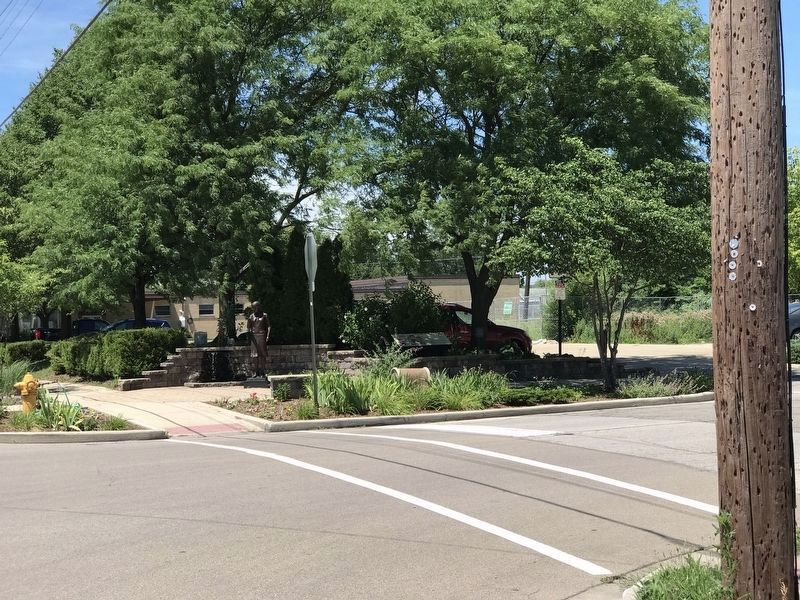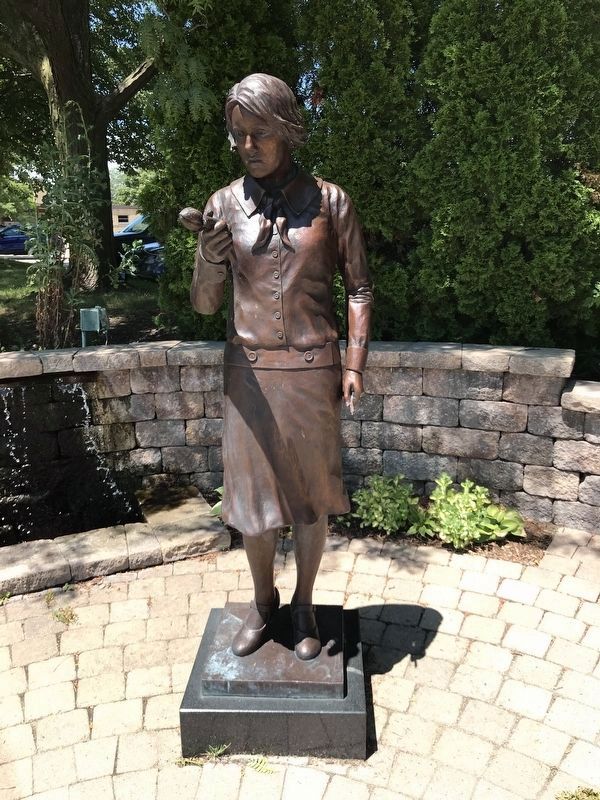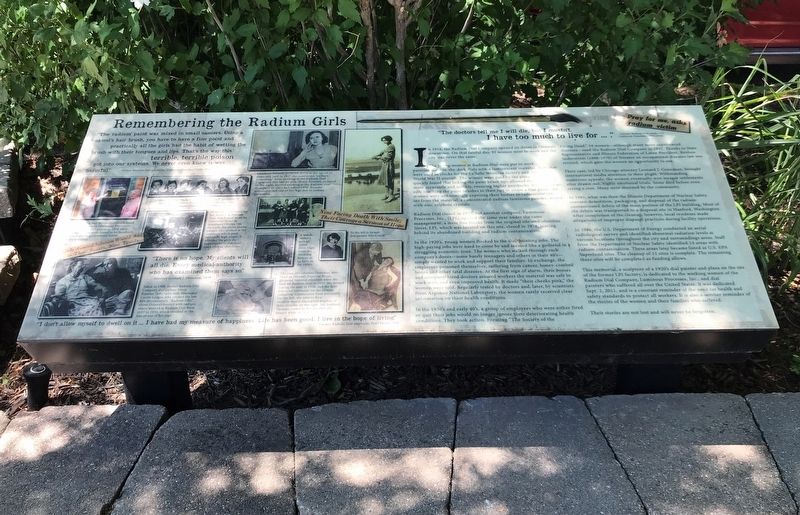Ottawa in LaSalle County, Illinois — The American Midwest (Great Lakes)
Remembering the Radium Girls
“The doctors tell me I will die, but I mustn't. I have too much to live for …” — Former Radium Dial employee, Catherine Donohue (1903-1938)
In 1918, the Radium Dial Company opened its doors in Ottawa's downtown. On that fateful day, 92 women went to work and the city was never the same.
The young women at Radium Dial were put to work painting glow-in-the-dark dials with a luminescent material, dials that were used in clocks for the La Salle Westclox factory and, later, for World War II aircraft. The women were paid by the piece, and they quickly found that licking the paint brush tips allowed them to paint more accurately and quickly, ensuring higher paychecks. But by repeatedly touching the paint brushes to their lips to attain a fine point, the women were unknowingly exposing their bodies to radioactive toxins from the material: a concentrated-radium luminous powder, mixed with zinc sulphide crystals.
Radium Dial closed in 1937, but another company, Luminous Processes, Inc., (LPI), opened the same year under the same management, a mere five blocks from the original site on Columbus Street. LPI, which was located on this site, closed in 1978, leaving behind its abandoned building and radium contamination.
In the 1920's, young women flocked to the dial-painting jobs. The high-paying jobs were hard to come by and seemed like a godsend in a struggling economic time. The women who walked through each company's doors – some barely teenagers and others in their 40's – simply wanted to work and support their families. In exchange, the employees poisoned themselves, suffering from cancer, honey-combed bones and other fatal diseases. At the first sign of alarm, their bosses and company-hired doctors assured workers the material was safe to work with and even improved health. It made “their cheeks pink,” the women were told. Regularly tested by doctors and, later, by scientists from Argonne National Laboratory, the women rarely received clear information on their health conditions.
In the 1930's and early 40's, a group of employees who were either fired or quit their jobs would no longer ignore their deteriorating health conditions. They took action. Forming “The Society of the Living Dead,” 14 women – although many more experienced illnesses – sued the Radium Dial Company in 1937. Thanks to State Representative and Illinois Federation of Labor President, Reuben Soderstrom (1888-1970) of Streator an occupational diseases law was revived, which gave the women an opportunity to sue.
Their case, led by Chicago attorney Leonard J. Grossman, brought international media attention to their plight. Withstanding numerous appeals, the women

Photographed By Duane and Tracy Marsteller, July 10, 2022
2. Remembering the Radium Girls Marker
The memorial plaza is on the site of the former Luminous Processes, Inc. (LPI) facility, founded by former Radium Dial president Joseph Kelly after he was ousted from that company in 1934. LPI operated until 1976, when federal regulators found radiation levels up to 1,666 times higher than the allowable amount at the facility. The Superfund site was ultimately cleaned up and is now a parking lot.
In 1985, what was then the Illinois Department of Nuclear Safety oversaw demolition, packaging, and disposal of the radium-contaminated debris of the main portion of the LPI building. Most of the debris was transported to a disposal site in Hanford, Washington. After completion of the cleanup, however, local residents made allegations of improper disposal practices during facility operations.
In 1986, the U.S. Department of Energy conducted an aerial radiological survey and identified abnormal radiation levels at various locations throughout the city and surrounding areas. Staff from the Department of Nuclear Safety identified 14 areas with radium contamination. These areas later became listed as U.S. EPA Superfund sites. The cleanup of 11 sites is complete. The remaining three sites will be completed as funding allows.
This memorial, a sculpture of a 1920's dial painter and plaza on the site of the former LPI factory, is dedicated to the working women of the Radium Dial Company, Luminous Processes, Inc., and dial painters who suffered all over the United States. It was dedicated Sept. 2, 2011, and is a constant reminder the need for health and safety standards to protect all workers. It is also a somber

Photographed By Duane and Tracy Marsteller, July 10, 2022
3. Radium Girl Memorial Statue
The memorial was the 2006 brainchild of then eighth-grader Madeline Piller, who learned about what had happened in her hometown and was amazed that few seemed to know about it. She launched a campaign to erect a memorial, and the town commissioned her father, sculptor William Piller, to create the life-size bronze statue of a 1920s 'Radium Girl'. The girl holds paintbrushes in one hand and a limp tulip in the other, signifying the radioactivity inside of her.
Their stories are not lost and will never be forgotten.
“The ‘radium’ paint was mixed in small saucers. Using a camel's hair brush, you have to have a fine point and practically all the girls had the habit of wetting the brush with their tongues and lips. That's the way this terrible, terrible poison got into our systems. We never even knew is was harmful.” — Former Radium Dial employee, Catherine Donohue (1903-1938)
“There is no hope. My clients will all die. Every medical authority who has examined them says so.” — Attorney Leonard J. Grossman, 1938
“I don't allow myself to dwell on it … I have had my measure of happiness. Life has been good. I live in the hope of living.” — Former Radium Dial employee, Pearl Payne, 1938
[Captions:]
Phyllis Young and Midge Hartshorn stand outside the former Luminous Processes, Inc. building. LPI closed in 1978 after radiation levels were found to be hundreds of times above government limits in the building.
Above are the “Society of the Living Dead” members Helen Munch, Marie Rossiter, Marguerite Glacinski, Olive Witt, Frances O'Connell, and Maxine Smith.
Charlotte Purcell, pictured above at the age of 31 years old, said in 1937 she contracted “radium poisoning” from working at the Radium Dial Company. She lost an arm. Marie Rossiter, pictured to the right, started working at the Radium Dial Company in 1923 and left in 1930. Rossiter eventually lest one of her legs due to radium poisoning.
To the left, employees are fast at work at Radium Dial, which used to sit on Columbus Street in downtown Ottawa. On the right, the photo shows women who worked at the company, which paid unusually high wages. It afforded the girls the opportunity to purchase fancy clothes and shoes.
A watch-maker's college group from Elgin visits the Westclox factory in La Salle in the 1930's.
To the left is former dial painter Ella Cruise.
Taken in 1988, former Radium Dial Company dial painter Marie Rossiter (left) talks with filmmaker Carole Langer, who created the late 80's documentary, “Radium City,” about Ottawa's history with radium. Marie worked at Radium Dial from 1923 to 1930, which resulted in the loss of one of her legs.
The case of Catherine Donohue, who lived on Ottawa's Superior Street, garnered national attention when she Radium Dial in 1937. She fainted during the trial in 1938, and she later delivered testimony for the Illinois Industrial Commission from her couch. On the left, she mimics how workers would place paint brushes in their mouths. To the right, her husband, Thomas, comes to her aid after she fainted while on trial.
Erected 2011.
Topics. This historical marker is listed in these topic lists: Disasters • Industry & Commerce • Women. A significant historical year for this entry is 1937.
Location. 41° 20.884′ N, 88° 50.655′ W. Marker is in Ottawa, Illinois, in LaSalle County. Marker is at the intersection of Clinton Street and West Jefferson Street, on the right when traveling south on Clinton Street. Touch for map. Marker is at or near this postal address: 809 Clinton St, Ottawa IL 61350, United States of America. Touch for directions.
Other nearby markers. At least 8 other markers are within walking distance of this marker. First Lincoln-Douglas Debate (about 600 feet away, measured in a direct line); The Daily Times (about 700 feet away); Jim Gray's Escape to Freedom (about 700 feet away); Lincoln the Litigator (about 700 feet away); In Memory of W.R. Foster (about 700 feet away); LaSalle County Civil War Soldiers Memorial (about 800 feet away); Lasalle County Courthouse (approx. 0.2 miles away); Stephen Douglas (approx. 0.2 miles away). Touch for a list and map of all markers in Ottawa.
Also see . . .
1. The Radium Girls: An Illinois Tragedy. Although dial painters in other states also sought retribution for their fatal illnesses, those in Ottawa were the only ones to win state sanctioned compensation. Even so, the amount was meager: Radium Dial fled Illinois and paid only $10,000 in compensation. (By Tara McClellan McAndrew, NPR Illinois, posted Jan. 25, 2018) (Submitted on July 16, 2022, by Duane and Tracy Marsteller of Murfreesboro, Tennessee.)
2. In Her Footsteps: Radium Girls of Ottawa, IL. Erika Holst, Curator of History for the Illinois State Museum, narrates the tragic tale of the brave factory workers whose quest for justice forever changed US Labor laws. (Illinois State Museum, uploaded May 8, 2021) (Submitted on July 16, 2022, by Duane and Tracy Marsteller of Murfreesboro, Tennessee.)
3. Radium Girls: Living Dead Women. This Library of Congress "Headlines and Heroes" blog post includes contemporary newspaper ads and articles about the court cases. (By Arlene Balkansky, posted March 19, 2019) (Submitted on July 16, 2022, by Duane and Tracy Marsteller of Murfreesboro, Tennessee.)
4. The Girls. Biographical sketches of several dial-painters from Illinois and New Jersey who sought compensation for their radium-caused illnesses. (Kate Moore, The Radium Girls) (Submitted on July 16, 2022, by Duane and Tracy Marsteller of Murfreesboro, Tennessee.)
Credits. This page was last revised on April 6, 2024. It was originally submitted on July 16, 2022, by Duane and Tracy Marsteller of Murfreesboro, Tennessee. This page has been viewed 2,311 times since then and 790 times this year. Photos: 1, 2, 3. submitted on July 16, 2022, by Duane and Tracy Marsteller of Murfreesboro, Tennessee.
